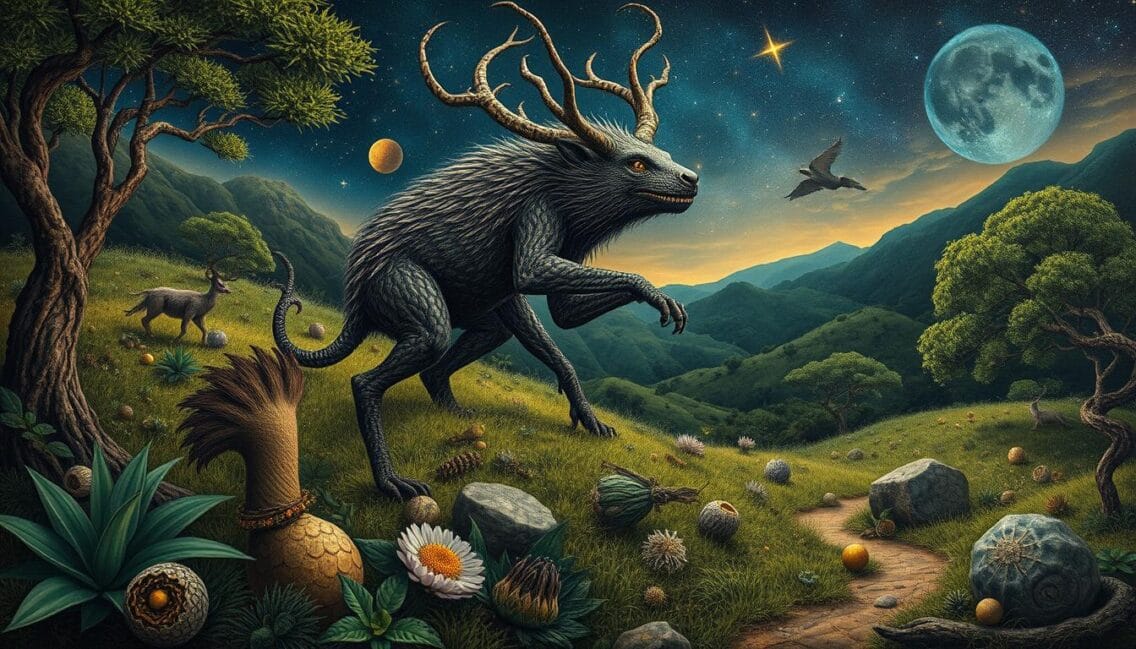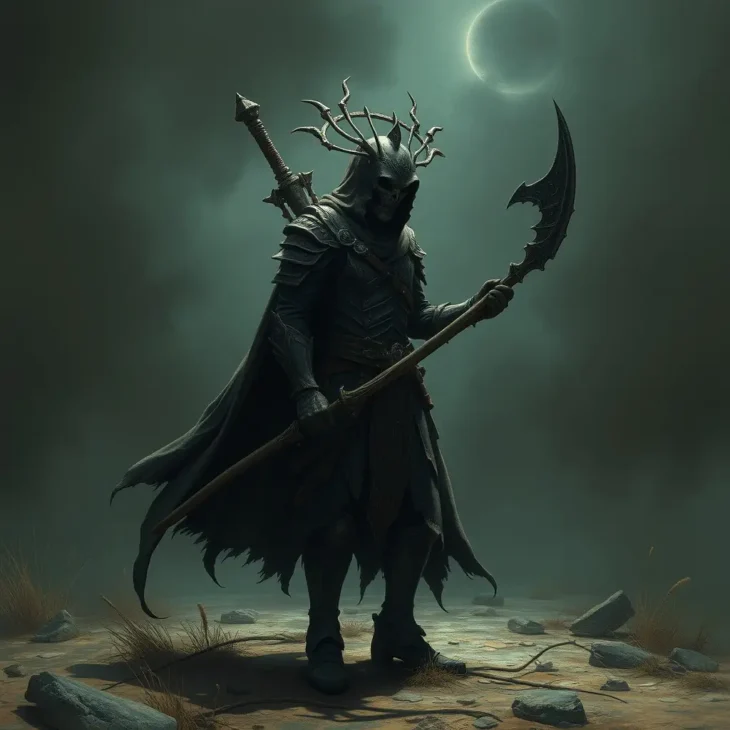The Tokoloshe: South African Folklore & Safeguards

Imagine a world where the unseen can deeply affect your life. Ancient spirits hide in the shadows, waiting to cause trouble. This is the world of the tokoloshe, a fascinating creature in South African folklore.
As you explore this tale, you’ll enter a world where the natural and supernatural mix. Here, traditions and beliefs meet, and finding protection against the tokoloshe is crucial.
What is a Tokoloshe?
The Mythology Behind the Tokoloshe
The tokoloshe is a small water spirit from Nguni mythology. It’s mischievous and evil. It can turn invisible by drinking water or swallowing a stone.
People who are mean call on the tokoloshe to scare others. This can include scaring kids or making people sick or even dead.
This spirit started in Bantu folklore. It was to explain why people were dying in their homes at night. To protect against it, people raise their beds and seek help from spiritual leaders.
The tokoloshe is known by many names in Southern Africa. Names like Tikolosh, Thokolosi, Hili, Mwari, Chihura, and Hilihili are used. These dwarf-like water spirits look like children in some places.
The Tokoloshe has also made its way into modern popular culture. It’s seen in movies, books, video games, comics, cartoons, and music. It’s said to have superhuman strength, illusion-casting capabilities, and can steal vital essence from its victims.
The Tokoloshe is a big part of Xhosa mythology and folklore in South Africa. It shows its importance in African culture. It’s mainly found in the beliefs of the Zulu, Xhosa, and other Bantu-speaking tribes of Southern Africa.
Origins and Explanations
The tokoloshe, a dwarf-like water spirit, is a key part of southern African myths. It was created to explain sudden deaths among the Bantu people. These deaths were often due to carbon monoxide poisoning from wood fires in poorly ventilated huts.
People believed that sleeping on high beds could protect them from the tokoloshe’s curse. This myth helped the Bantu culture understand the unexplained. It made sense of the mysterious deaths.
The tokoloshe is seen as a mischievous and evil spirit. It can turn invisible by drinking water or swallowing a stone. It’s believed to be called upon by bad people to scare, harm, or even kill. To avoid it, people raise their beds and seek help from spiritual leaders.
Even though it’s seen as a myth, many in southern Africa still believe in the tokoloshe. It has also inspired music, films, and books in South Africa and worldwide.
| Legendary Creatures of African Folklore | Attributes |
|---|---|
| Mokele-Mbembe | Massive, sauropod-like animal that inhabits the swamps and rivers of Central Africa |
| Grootslang | Embodies the strength of an elephant with the intelligence and stealth of a serpent, originating from South Africa |
| Inkanyamba | Has the head of a horse and is believed to control storms and weather patterns, dwelling at the base of Howick Falls in South Africa |
| Mamlambo | A complex figure in African mythology, embodied as the “Goddess of Rivers” with a dual nature capable of bestowing blessings or curses |
| Adze | A shapeshifting vampire from West Africa, with the ability to transform into a firefly to gain entry into homes to feed on blood |
| Popobawa | A shape-shifting demon from Zanzibar, Tanzania, that emerges at night to spread fear and chaos throughout the community |
The Tokoloshe: South African Folklore and Its Safeguards Against Evil Entities
Traditional Safeguards
In South African folklore, the Tokoloshe is a powerful and dangerous entity. It’s believed to cause harm, illness, and even death. To protect against it, South Africans use traditional methods.
Raising your bed off the ground is a key defense. The Tokoloshe can’t climb, so this simple act helps keep it away. People also seek help from spiritual figures like pastors or traditional healers. These individuals are thought to have the power to ward off the Tokoloshe.
The Tokoloshe is linked to evil people who use it to harm others. This shows why traditional safeguards are so important. They help protect against this powerful supernatural threat.
Cultural Significance and Impacts
The tokoloshe is a big part of South African culture. It affects how people act and how society works. Sometimes, people blame the tokoloshe for strange events or crimes, like sewing needles in kids’ bodies. But, it’s often just a cover-up for real issues like child abuse.
Also, the tokoloshe is linked to sexual assault cases. Victims might say the tokoloshe did it to avoid shame or anger from their community.
In traditional stories, the tokoloshe is seen as a playful troublemaker. But today, it’s linked to serious and scary actions. This shows how supernatural beliefs and impact on behavior and society of the tokoloshe have grown in South African culture. The fear of the tokoloshe’s power, whether through scapegoating or sexual assault allegations, shows how strong these supernatural beliefs are in shaping our views and actions.
- The tokoloshe is deeply ingrained in South African culture, impacting behavior and societal dynamics.
- The tokoloshe has been used as a scapegoat to explain unexpected events or crimes, such as child abuse.
- The tokoloshe has been associated with allegations of sexual assault, as victims may claim the creature was the perpetrator.
- The role of the tokoloshe has evolved from a mischievous trickster to encompassing more serious and disturbing acts.
- The belief in the tokoloshe’s ability to cause harm reflects the deep-rooted supernatural beliefs that continue to shape perceptions and behaviors within South African communities.
Tokoloshe in Popular Culture
The tokoloshe has become a big part of South African culture. It’s a small, mischievous water spirit that artists, writers, and musicians love. They’ve put the tokoloshe in their work, making it a part of their stories.
In “Madam & Eve,” a popular comic strip, the tokoloshe is always up to something funny. It’s known for being playful but a bit troublesome. The song “Tokoloshe Man” by John Kongos also became a hit, showing how the tokoloshe is loved in music.
South African movies like “The Bone Snatcher” and “A Reasonable Man” feature the tokoloshe. They show how the creature is seen in different ways. In the music video for “Evil Boy” by Die Antwoord, the tokoloshe is shown as scary and violent.
These examples show how the tokoloshe is seen in many parts of South African culture. From comics to music and movies, it’s a big part of the country’s stories. Its presence in media and arts shows how deeply it’s connected to South Africa’s folklore and mythology.
| Medium | Examples |
|---|---|
| Comic Strips | “Madam & Eve” |
| Music | “Tokoloshe Man” by John Kongos, “Evil Boy” by Die Antwoord |
| Film | “The Bone Snatcher,” “A Reasonable Man” |
Conclusion
The tokoloshe is a key part of South African folklore and mythology. It has a rich history and cultural importance that goes beyond simple myths. This powerful, sometimes evil creature has fascinated South Africans for many years.
It has shaped how people behave and interact with each other. It also influences popular culture. The tokoloshe’s story may have started with real events, like carbon monoxide poisoning. But it shows how people try to understand the unknown through myths.
The tokoloshe’s role in South African folklore and its ongoing influence on culture show the lasting power of mythological creatures. It has become a part of everyday life, from protecting against its tricks to being a big part of popular culture. This shows how strong and flexible South African folklore is.
Exploring South African mythology, the tokoloshe stands out as a fascinating and complex figure. It shows how powerful our imagination is in facing the world’s mysteries. Whether you believe in the tokoloshe or not, its lasting impact on South African culture is clear. It reminds us of the deep influence of folklore and mythology on a society’s shared thoughts and feelings.
FAQ
What is a Tokoloshe?
The tokoloshe is a water spirit from Nguni mythology. It looks like a dwarf and is very mischievous. It can turn invisible by drinking water or swallowing a stone.
How are Tokoloshes used?
People who want to harm others call upon the tokoloshe. It can scare kids, make people sick, or even kill them.
How can you protect yourself from a Tokoloshe?
To keep safe, you can raise your bed off the ground. You can also ask for help from spiritual leaders like pastors or traditional healers. They can help banish the tokoloshe.
Where did the Tokoloshe come from?
The tokoloshe story started in Bantu folklore. It was used to explain sudden deaths in rondavels at night. Now we know it was due to carbon monoxide poisoning.
How is the Tokoloshe viewed in South African culture?
In South Africa, the tokoloshe is seen as very powerful and dangerous. It’s a big part of the culture. People believe in it and it affects how they behave and interact with each other.
How is the Tokoloshe represented in South African popular culture?
The tokoloshe shows up a lot in South African culture. It’s in comics, music, and movies. This shows how deep it is rooted in the country’s folklore and mythology.



